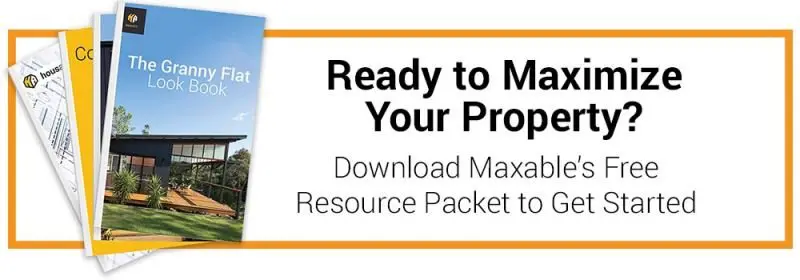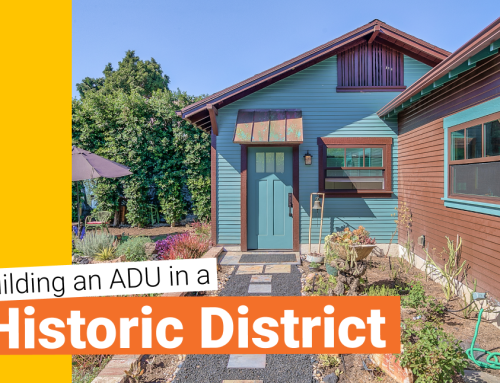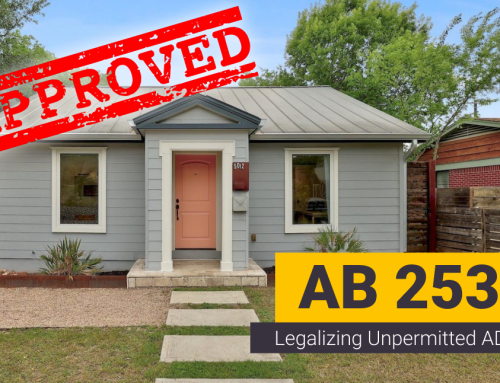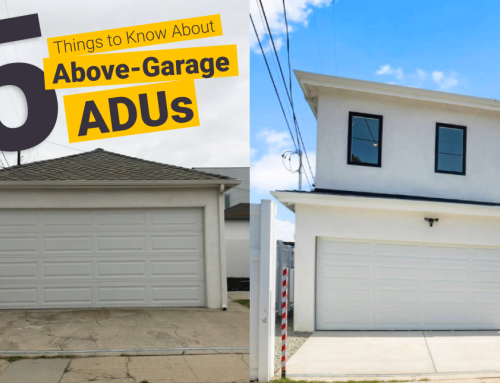For the last few years, the California government has passed numerous granny flat bills, making these cozy backyard homes (formally known as accessory dwelling units, or ADUs) from relatively unknown entities into a household name within the real estate industry.
So, what do these new laws mean and what are the granny flat regulations for California?
Maxable sat down with Jared Basler, a seasoned ADU designer in the San Diego area, to break down what these bills mean and how they’ll define your granny flat project.
State Law Overrides All Prior Jurisdiction Granny Flat Regulations
Prior to 2017, granny flat laws were outlined separately in each of California’s 543 jurisdictions. That means each jurisdiction had passed its own granny flat ordinance — most of which placed incredible restrictions and fees on homeowners.
California lawmakers recognized the gross overregulation at the local level and signed government code 65852.2 into state law. Thankfully, these archaic regulations regarding minimum lot sizes, parking restrictions, you name it, are now null and void.
“This state law overrides all local jurisdictions,” said Basler. “The state of California needs more housing and they realized that to do that, they needed to relax very restrictive and outdated laws.”
Jurisdictions that fail to comply with state regulations may face hefty fees or lawsuits from the California Department of Housing & Community Development (HCD). However, jurisdictions do have some liberties to an extent.
Lets chat about your ADU! 888-461-3884
Jurisdictions Can Write Their Own Granny Flat Ordinance
While California’s new state law regulates granny flat projects across the board with no exceptions, local jurisdictions still retain the legal right to draft their own ordinances – provided that their regulations are not more restrictive than the state regulations. This is why you may be able to do things that your friend five miles away can’t.
For example, the state sets setback requirements at four feet for side and rear. However, several cities have taken it a step further and decreased setbacks to as little as ZERO feet, meaning you can place your ADU all the way to your property line. San Diego is an example of one of those cities.
Regulations that haven’t been defined by the state are also open to be outlined by each individual city. A few examples of those:
- Rental term lengths
- Front setbacks*
- Floor-area ratio*
- Min lot size*
*These regulations can only be enforced to an extent. These regulations are state exempt, meaning if any of these regulations prevent you from building an ADU that is at least 800 sq. ft., they cannot be enforced. We’ll talk more on this later.
Find out if your jurisdiction has written its own ordinance here, or schedule a call with the Maxable team to talk one-on-one about what’s possible in your city.
Now, let’s examine the California’s state standards.
Basic Granny Flat Requirements
A granny flat, or accessory dwelling unit (ADU), is intended for long-term living. As such, they are required to have:
- A permanent foundation
- Full kitchen including cooking stove, countertops, and refrigerator
- Bedroom or sleeping area if building a studio
- Full bathroom
- Utilities including electric, water, and storage
- Insulation
- Separate entrance
Essentially, everything you would expect to find in a full-sized home or apartment needs to be included in your granny flat.
What Properties are Eligible to Build a Granny Flat?
Any single-family or multi-use property in California can now build a granny flat on their property. This includes properties with duplexes, triplexes, and apartment buildings. Any existing structure, like a garage or basement, can be converted into an accessory dwelling unit.
Not sure what your zone is? You can visit ScoutRed.com to figure it out, or contact Maxable.
Granny Flat Size Regulations
All residential properties in California are allowed to build at least one 800 sq. ft. granny flat, regardless of floor area ratio, lot size, and the size of the existing primary residence.
What if your house is only 800 square feet? Can you still build a unit that’s also 800 square feet? Absolutely.
Larger granny flat sizes are available under different conditions:
- 850 sq. ft. for units with one bedroom
- 1,000 sq. ft. for units with two bedrooms or more
- 50% of the primary residence for attached granny flats (unless this number is less than 800 sq. ft. In that case, you would still be allowed an 800 sq. ft. unit)
- 1,200 sq. ft. max for detached ADUs
Keep in mind that these are the state regulations, but cities can pass their own ordinances that would allow larger.
The final size consideration is unlimited. If you want to convert an existing structure into a granny flat, there is no size restriction. For example, if you have a 2,000 sq. ft. barn on your property, the entire structure can be converted.
Parking Requirements
No additional parking is required IF:
- You’re converting an existing permitted space, like your garage
- Your property is within half a mile of a transit stop
- Your property is located within an architecturally or historically significant district
- Street parking permits are required but not offered to the occupant of the ADU.
If you don’t qualify for either of those, you will need to provide parking. Luckily, the law allows you to place parking anywhere on your lot, but it must be hardscaped for parking, meaning you can’t park a car on your lawn. Unlike before, parking may now exist as a tandem in an existing driveway. One parking spot typically measures 10×18′.
Setback Requirements
Setbacks for granny flats must be at least 4 ft. for the side and rear. Front setbacks are set by local zoning laws, however, they cannot be enforced if they prevent a homeowner from building an 800 sq. ft. ADU
If you are converting a structure, like a garage, there are no setback requirements. As long as you stay within the existing footprint of the structure, you do not need to worry about setbacks.
Granny Flat Fees
You do not need to pay development and impact fees if your granny flat is smaller than 750 sq. ft.
However, if your ADU is larger, you’re still in luck. The fees are calculated proportionally to the size of the ADU. Previously, building an accessory dwelling unit was extremely cost-prohibitive because the city charged the same impact fees as building a brand new house, which could be up to $80,000!
Fees will vary depending on your city, the type of ADU, and the size. In San Diego, you can expect to pay around $20,000 in fees to the city, potentially less if you’re converting space within an existing home.
Historical Review Fees
A historical review will be required before your plans are approved if your home is older than 45 years. The city will look at your home in a vacuum and assess things like, have you made exterior changes? Are all the windows matching or are half vinyl? You’ll also be required to submit a copy of the building record. Historical reviews are typically several thousand dollars.
Granny Flat FAQs
Do I need a permit to build a granny flat?
Yes, in California and most other states, you will need to obtain a building permit from your local Planning Department before you can begin construction on a granny flat—also known as an accessory dwelling unit (ADU). The permitting process ensures your project complies with local zoning laws, building codes, and safety regulations.
Obtaining a permit typically involves submitting a complete ADU permit set for review by the city. This set must include architectural drawings, floor plans, elevations, site plans, utility layouts, structural calculations (if applicable), and energy compliance documentation (Title 24 in California). Depending on your city, you may also need to coordinate with other departments, such as Public Works or the Fire Department.
Because of the complexity and technical requirements involved, it’s highly recommended to hire an experienced designer, architect, or draftsperson to prepare and submit your plans.
Can I rent my granny flat?
You may rent your accessory dwelling unit, but your jurisdiction may place restrictions on short-term vacation rentals. For example, in San Diego, you cannot rent your granny flat legally on Airbnb.
Can you permit an illegally built structure?
Yes. You can retroactively permit an illegally built structure without worrying about penalization. However, it must be brought up to current code. A lot of times energy efficiency is the hard part, but it’s easier to bring a building to code when starting from scratch. Check out how Maxable helped this Los Angeles resident bring his cozy garage conversion up to code in a flash!
If you’re interested in taking advantage of these new regulations, you can start with downloading our free tool kit.
Does my granny flat need to have solar panels?
Only new-built detached granny flats are required to have solar panels, either on the unit itself or on the primary residence. Attached ADUs, conversions, and modular constructed ADUs are exempt from the solar panel requirement.
Plan, hire, and manage your ADU project with Maxable.
At Maxable, we believe that building an ADU should be fun and exciting. You shouldn’t have to be the one to deal with confusing obstacles like permitting snafus or ever-changing regulations. We’ll be by your side every step of the way and connect you to experienced designers and general contractors in your area to make sure your project goes as smoothly as possible.
Leave the headaches to us! Check your address and see what Maxable can do for your home during an ADU Planning Call.










